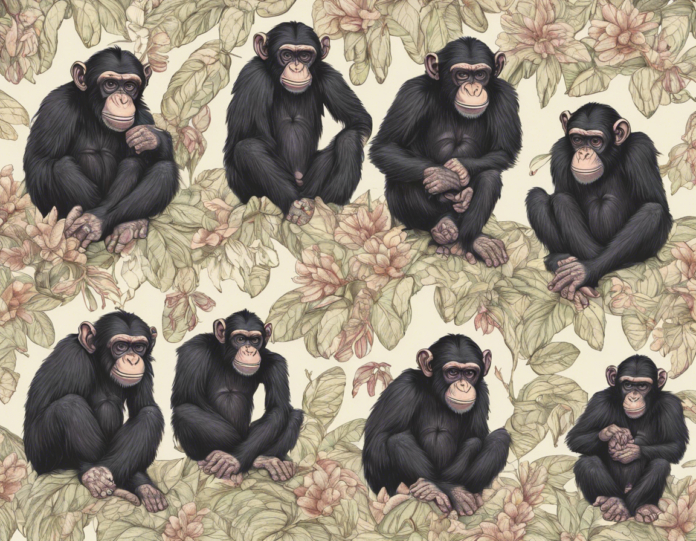Introduction
Vanilla is not just a beloved flavor in the culinary world; it also has a fascinating connection with wild chimpanzees. These primates, known for their intelligence and social behaviors, have a unique relationship with the vanilla plant that provides insights into their foraging habits, communication, and cultural practices. In this article, we will explore the sweet connection between vanilla and chimpanzees in the wild.
The Vanilla Plant: a Prized Resource
In the lush forests of Africa, where chimpanzees roam freely, the vanilla plant (Vanilla planifolia) grows abundantly. This orchid species is highly valued by humans for its aromatic pods, which contain seeds used to flavor a variety of dishes and products. Interestingly, chimpanzees also appreciate the rich scent and taste of vanilla pods, making them a sought-after treat in their diet.
Foraging Behavior
Chimpanzees are omnivores with a diverse diet that includes fruits, leaves, insects, and occasionally meat. When it comes to vanilla, these primates exhibit selective foraging behavior, showing a preference for ripe pods with a strong aroma. They use their keen sense of smell to detect the distinctive scent of vanilla, guiding them to the most flavorful pods.
Cultural Transmission
One of the most intriguing aspects of chimpanzee behavior is their ability to learn from one another and pass on knowledge through generations. In the case of vanilla consumption, researchers have observed cultural transmission of foraging techniques related to extracting the seeds from the pods. Young chimpanzees watch and imitate the methods used by older individuals, highlighting the social dynamics involved in acquiring this specialized food source.
Communication and Social Bonds
Chimpanzees are highly social animals that communicate through a complex system of vocalizations, gestures, and behaviors. When it comes to sharing vanilla pods, these primates engage in social interactions that strengthen bonds within their groups. By offering a prized treat to another chimpanzee, individuals can enhance social cohesion and reinforce alliances.
Nutritional Benefits
Beyond the sensory pleasure of consuming vanilla pods, chimpanzees derive nutritional benefits from this food source. The seeds inside the pods are rich in essential oils and aromatic compounds that may offer microbial and medicinal properties. By incorporating vanilla into their diet, chimpanzees may enhance their overall health and well-being in the wild.
Conservation Implications
The relationship between chimpanzees and vanilla plants underscores the interconnectedness of wildlife and their habitats. As human activities, such as deforestation and illegal poaching, threaten both chimpanzee populations and natural habitats where vanilla grows, conservation efforts are crucial to safeguarding these ecosystems. By protecting the environments where chimpanzees forage for vanilla, we can ensure the survival of these iconic primates and the diverse plant species they rely on.
Frequently Asked Questions (FAQs)
- Do all chimpanzee populations consume vanilla pods?
-
While not all chimpanzee populations have access to vanilla plants in their natural habitats, those living in regions where this orchid species grows are known to include it in their diet.
-
Are there any health risks associated with chimpanzees eating vanilla?
-
In general, vanilla consumption is considered safe for chimpanzees. However, excessive intake of certain aromatic compounds found in the pods may have potential health implications, so moderation is key.
-
Can vanilla pods serve as enrichment for chimpanzees in captivity?
-
Yes, vanilla pods can be used as sensory enrichment for captive chimpanzees, providing them with mental stimulation and a novel food item to interact with.
-
Do chimpanzees show preferences for specific varieties of vanilla pods?
-
Research suggests that chimpanzees may exhibit preferences for certain types of vanilla pods based on their scent, flavor, and ripeness. Individual differences in taste preferences can also influence their choices.
-
How do researchers study the relationship between chimpanzees and vanilla plants in the wild?
- Scientists use a combination of field observations, behavioral studies, camera traps, and DNA analysis of fecal samples to investigate the interaction between chimpanzees and vanilla plants in their natural habitat.
In conclusion, the connection between vanilla and chimpanzees in the wild offers a glimpse into the complex behaviors and dietary preferences of these remarkable primates. By exploring how these animals interact with their environment and other species, we gain a deeper appreciation for the intricate web of life that sustains biodiversity in our world.


Recent comments